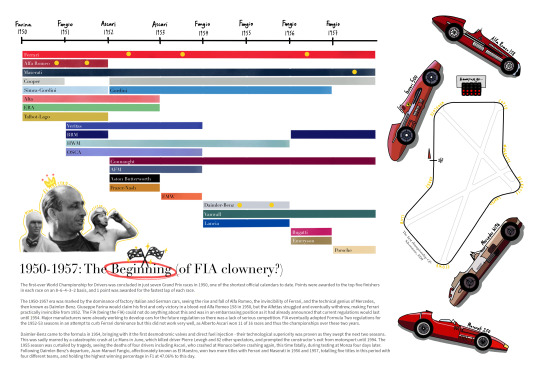#can you believe it stemmed from watching seb name the wdcs in order one too many times
Text

F1: a colorised history 1/10 - text and graphics mine with thanks to Wikipedia and Reddit
text in photo below the cut :) if you spot any mistakes please let me know!
The first-ever World Championship for Drivers was concluded in just seven Grand Prix races in 1950, one of the shortest official calendars to date. Points were awarded to the top five finishers in each race on an 8–6–4–3–2 basis, and 1 point was awarded for the fastest lap of each race.
The 1950-1957 era was marked by the dominance of factory Italian and German cars, seeing the rise and fall of Alfa Romeo, the invincibility of Ferrari, and the technical genius of Mercedes, then known as Daimler-Benz. Giuseppe Farina would claim his first and only victory in a blood-red Alfa Romeo 158 in 1950, but the Alfettas struggled and eventually withdrew, making Ferrari practically invincible from 1952. The FIA (being the FIA) could not do anything about this and was in an embarrassing position as it had already announced that current regulations would last until 1954. Major manufacturers were already working to develop cars for the future regulation so there was a lack of serious competition. FIA eventually adopted Formula Two regulations for the 1952-53 seasons in an attempt to curb Ferrari dominance but this did not work very well, as Alberto Ascari won 11 of 16 races and thus the championships over these two years, remaining the last Italian driver to do so.
Daimler-Benz came to the formula in 1954, bringing with it the first desmodromic valves and direct fuel injection - their technological superiority was proven as they swept the next two seasons. This was sadly marred by a catastrophic crash at Le Mans in June, which killed driver Pierre Levegh and 82 other spectators, and prompted the constructor's exit from motorsport until 1994. The 1955 season was curtailed by tragedy, seeing the deaths of four drivers including Ascari, who crashed at Monaco before crashing again, this time fatally, during testing at Monza four days later.
Following Daimler-Benz’s departure, Juan-Manuel Fangio, affectionately known as El Maestro, won two more titles with Ferrari and Maserati in 1956 and 1957, totalling five titles in this period with four different teams, and holding the highest winning percentage in F1 at 47.06% to this day.
#timeline#this is basically as close to fanart as i will ever get#tiny drawings of the 1950s cars#this was so ridiculously fun to do#can you believe it stemmed from watching seb name the wdcs in order one too many times#halfway through my fifth rewatch i was like#hey i don't really know about half of these people..#and so now i have taken it upon myself to do a Full And Comprehensive history of motorsport...#anyway i hope this is useful or at least nice to look at :")#because a lot of timeline spreadsheets ive seen are just uh. unusable#claire's edits#alberto ascari#juan manuel fangio#giuseppe farina#classic f1#f1#formula 1#i lowkey feel like this was designed very badly............... but OK#this was created for an audience of one (1) and that's me.#<3
16 notes
·
View notes